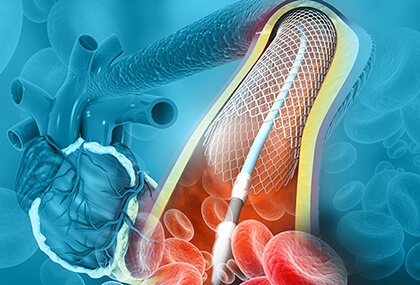Use of drug-coated balloons vs. drug-eluting stents in small caliber vessels.
The constant advancements in coronary device technology have significantly reduced complication rates (such as that of restenosis). However, there are gaps where a high number of undesirable events prevail, such as small vessel disease (SVD), for which, in previous studies up, the rate of treated vessel failure (TLF) was up to 2x at the 1-year follow-up.

Due to these observed complications, the use of drug-coated balloons (DCB) for de novo coronary lesions has increased, particularly for SVD.
The aim of this noninferiority, randomized, multicenter, open-label study conducted in five European centers (termed PICCOLETO II) was to assess the long-term (3-year) efficacy and safety of DCB with paclitaxel compared with the Xience everolimus drug-eluting stent (DES) by Abbott.
The study included patients hospitalized for stable and unstable coronary pathology who had an angioplasty (PCI) programmed. The angiographic admission criterion was the presence of disease in a reference vessel between 2 and 2.75 mm (SVD), with stenosis >70%. Patients with a diagnosis of ST-segment elevation coronary syndrome, severe calcification, very tortuous vessels, chronic total occlusions, truncal or aorto-ostial lesions, previous stent in the treated vessel, bifurcation lesions, and presence of high thrombotic burden were excluded.
The patients were randomized 1:1 to the DCB (Elutax SV) and DES (Xience) arms. Researchers suggested adequate preparation with predilatation and subsequent DCB inflation time of at least 30 seconds; in case of flow-limiting dissection bailout stenting would be performed.
The primary endpoint (PEP) was late loss of the treated lumen (LLL); the other endpoints studied were procedural success; major adverse cardiac events (MACE), defined as cardiac death, acute myocardial infarction and new vessel revascularization, and the individual components of MACE.
The study included 232 patients; their mean age was 65 years, 70% of them were male, and 50% had a history of percutaneous coronary treatment.
In 55% of the cases, the indication for treatment was stable angina and 15% unstable angina. The vessel treated in 40% of cases was the anterior descending artery and in 37% the circumflex artery. The mean balloon length used was 21.8±8.2mm, with 6.7% for bailout stenting.
Read also: Differences in Events Between MINOCA and MIOCA Patients: Contemporaneous Cohort Analysis.
When analyzing the PEP, there was superiority of DCB over DES in vessel LLL (0.04±0.28mm vs. 0.17±0.39mm; p = 0.03). There were no differences in mortality. In the DES arm, there were four events of thrombosis, while none in the DCB arm (p = 0.042). There was a nonsignificant decrease in TLR (8.8% vs.14.8%; p = 0.18), while the incidence of MACE was significantly lower with balloon use (10.8% vs. 20.8%; p = 0.046).
Conclusions
The PICCOLETO II study demonstrated safety and efficacy for the treatment of de novo lesions in small caliber vessels (<2.75mm), showing superior angiographic results with lower LLL and clinical outcomes with a lower MACE rate compared with the standard treatment, DES, at an average follow-up of 3 years.
These encouraging results have some limitations such as the open design and a sample power not calculated for clinical outcomes (PEP was an angiographic outcome).

Dr. Omar Tupayachi.
Member of the Editorial Board of SOLACI.org.
Original Title: Long-Term Outcome of Drug-Coated Balloon vs Drug-Eluting Stent for Small Coronary Vessels: PICCOLETO-II 3-Year Follow-Up.
Reference: Cortese B, Testa G, Rivero F, et al. Long-Term Outcome of Drug-Coated Balloon vs Drug-Eluting Stent for Small Coronary Vessels. J Am Coll Cardiol Intv. null2023, 0 (0). https://doi.org/10.1016/j.jcin.2023.02.011.
Subscribe to our weekly newsletter
Get the latest scientific articles on interventional cardiology





